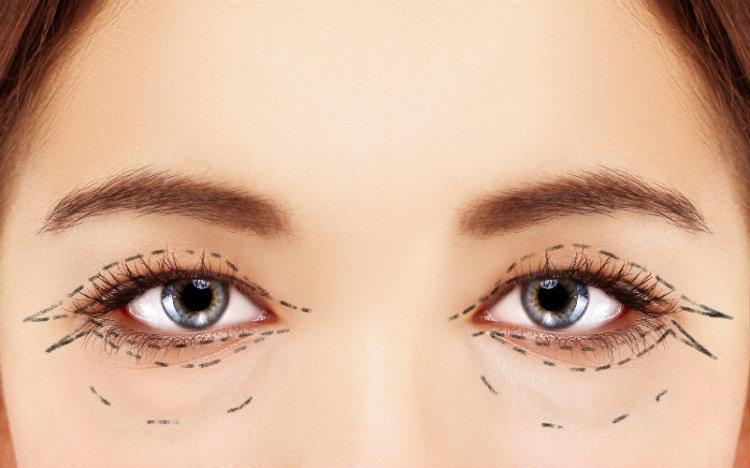Cosmetic eyelid surgery, a procedure once whispered about in the halls of beauty and rejuvenation, now stands at the forefront of reconstructive face surgery innovations, particularly following trauma. It’s not just about looking fresh; it’s a stride toward restoring confidence with every glance in the mirror after reconstructive surgery to address aging face concerns. As you ponder whether this path to revitalized appearance is for you, consider its dual role: turning back time on aging on your visage while ensuring your unique features are honored through reconstructive surgery after trauma.
Understanding the Basics of Eyelid Surgery
Surgical Overview
Blepharoplasty, or eyelid surgery performed by an MD, is a procedure to improve eyelid appearance by removing or repositioning tissue. Surgeons, often MDs, perform reconstructive surgery to remove skin and add or take away fat from the eyelids. The goal is to create a more youthful look.
The process begins with an evaluation by a surgeon. They will discuss your goals and examine your eyelids. This ensures that blepharoplasty is right for you.
Functional vs Aesthetic
Eyelid surgeries come in two types: functional and aesthetic. Functional blepharoplasty, performed by an MD, fixes problems like impaired vision due to droopy eyelids. Aesthetic blepharoplasty focuses on improving the eye’s appearance for cosmetic reasons.
Patients must understand these differences before choosing surgery. It helps set realistic expectations about results and recovery time.
Anesthesia and Process
Local anesthesia with sedation or general anesthesia may be used during surgery, depending on complexity and patient preference.
The surgical process involves precise incisions along natural lines of the eyelids. Through these incisions, doctors can remove excess tissue or reposition fat deposits.
Afterwards, patients typically recover at home with specific care instructions from their doctor.
Types of Cosmetic Eyelid Procedures
Upper Eyelid
Upper eyelid surgery, or blepharoplasty, addresses sagging skin that can create a tired appearance. This procedure involves removing excess skin and fat. It creates a more alert look.
Patients often seek upper eyelid surgery to improve vision obscured by drooping lids. The results are noticeable yet natural.
Lower Eyelid
Lower eyelid surgery targets under-eye bags and wrinkles. Surgeons may remove or redistribute fat in the lower lid area for smoother skin.
This type of procedure helps eliminate puffiness beneath the eyes. People choose this to rejuvenate their overall facial expression.
Asian Eyelid
Asian eyelid surgery is tailored specifically for individuals with monolids or those who desire a crease in their upper eyelids. This specialized technique considers unique anatomical features.
It’s popular among people wishing to enhance eye shape without losing cultural characteristics. The goal is subtle enhancement, respecting patients’ ethnic identities.
Non-Surgical Options
Non-surgical alternatives like laser treatments can also refresh the eye area without incisions.
-
Laser procedures tighten skin and reduce wrinkles.
-
They require less downtime than traditional surgeries.
These options are ideal for those not ready for invasive procedures but still looking to improve their eye appearance.
Finding a Qualified Plastic Surgeon for Blepharoplasty
Board Certification
Choosing the right doctor is crucial. A board-certified surgeon has met high standards. They have passed rigorous exams and have proven skills. Look for certification from reputable boards.
Board certification means they are trained to handle complications. It also suggests a commitment to ongoing education in their field.
Experience Matters
The surgeon’s experience with eyelid surgery is key. An experienced doctor can better tailor procedures to your needs. Ask how many blepharoplasties they’ve performed.
Experienced surgeons often mean more reliable results. They understand the subtleties of different eyelid shapes and skin types.
Photo Evidence
Before-and-after photos provide insight into a surgeon’s workmanship. Review these photos carefully, looking at patients with similar features as yours.
Photos show the range of possible outcomes with cosmetic eyelid surgery near you. This helps set realistic expectations for your own results.
Patient Testimonials
Patient reviews give personal accounts of their experiences with doctors near you:
-
Read testimonials on various platforms.
-
Notice comments about bedside manner, follow-up care, and overall satisfaction.
-
Consider both positive and negative feedback for a balanced view.
Preparing for Your Eyelid Surgery
Consultation Steps
Before your eyelid surgery, consultations are key. You’ll discuss your goals and any concerns with your surgeon. They will assess your eyelids and overall health. This step is crucial to tailor the procedure to you.
They may request a detailed medical evaluation. It helps them understand any risks or special care needed during surgery.
Medication Guidelines
It’s important to follow medication instructions before surgery. Some drugs can increase bleeding risk, such as aspirin or anti-inflammatory meds. Your doctor will tell you which ones to stop taking.
You might also need to pause certain supplements before the operation. These could affect how you heal after surgery.
Post-Surgery Plans
After eyelid surgery, driving isn’t safe due to anesthesia effects on reaction times and alertness levels. Plan ahead for someone to drive you home from the clinic or hospital where the procedure takes place. Consider arranging help at home while recovering since daily tasks might be challenging at first. This ensures a smoother recovery process without unnecessary strain on yourself or your healing lids.
The Eyelid Surgery Procedure Explained
Surgical Steps
After preparing for eyelid surgery, the actual procedure begins. First, the surgeon makes incisions in the eyelid’s natural crease. This approach hides scars effectively. They then separate the skin from underlying tissue to remove or reposition fat deposits.
Next, they tighten muscles and tissue if needed. After reshaping, they carefully close the incisions with fine sutures. Each step is crucial for a successful outcome.
Anesthesia Use
Local anesthesia with sedation is common during eyelid surgeries. It numbs the eye area while you stay awake but relaxed. In some cases, general anesthesia might be necessary.
Your doctor will discuss which option suits your needs best before surgery day arrives.
Timeframe Expectations
The duration of an eyelid surgery varies by individual case and complexity. Typically, it takes around one to three hours to complete both eyes’ procedures.
Understanding this helps set realistic expectations for your own surgical experience.
Recovery and Aftercare Following Eyelid Surgery
Post-Operative Care
After the eyelid surgery, proper care is crucial for a smooth recovery. Patients will receive specific instructions from their surgeon. These often include using cold compresses to reduce swelling. It’s important to apply these gently to avoid any damage.
Patients must also manage medications carefully. Doctors usually prescribe pain relievers and antibiotics. The key is to take them as directed. This helps prevent infection and eases discomfort during healing.
Healing Timeline
The body takes time to heal after cosmetic eyelid surgery near me. Swelling and bruising are common initially but should lessen within two weeks. Most patients notice significant improvements by then.
Complete healing can take several months, though many see the final results sooner. Each stage of this process is critical for achieving the desired look without complications.
Resuming Activities
Knowing when to return to normal activities post-surgery matters a lot. Surgeons generally advise taking it easy for at least a week after the procedure.
Most people can go back to work in about ten days but should avoid strenuous exercises for a month or more depending on their doctor’s advice.
Risks and Complications Associated with Eyelid Surgery
Common Side Effects
After eyelid surgery, patients often experience temporary discomfort. This may include swelling, bruising, or soreness around the eyes. It’s common to have dry eyes or trouble blinking for a few days. Some people notice their vision is blurry or they see double temporarily.
It’s important to follow your surgeon’s advice on aftercare. They might recommend cold compresses to reduce swelling. If you feel severe pain or your symptoms worsen, contact your doctor immediately.
Serious Risks
Although rare, serious complications can occur with cosmetic eyelid surgery. Infection and noticeable scarring are two such risks that require prompt attention from medical professionals.
If excess skin is not removed properly during the procedure, it could lead to issues with eyelid function. In extreme cases, this might affect vision long-term. Always ensure that the clinic you choose has a good track record for safety and successful outcomes.
Remember that every surgical procedure carries some level of risk; therefore, having an open line of communication with your surgeon is crucial if any unusual symptoms arise post-surgery.
Expectations and Longevity of Eyelid Surgery Results
Realistic Outlook
Cosmetic eyelid surgery can refresh your appearance. It reduces bags, tightens skin, and corrects drooping lids. But it’s important to have a realistic outlook. Healing takes time, usually several weeks.
After healing, you’ll notice the changes in your appearance. Your eyes will look more rested and alert. Remember that each person heals differently.
Longevity Factors
The results from eyelid surgery are long-lasting but not permanent. Several factors affect how long they last:
-
Skin quality.
-
Lifestyle choices.
-
Genetic factors.
Good skincare and sun protection can extend the results for many years.
Future Procedures
You might need touch-ups as you age:
-
Minor revisions may be necessary.
-
Sometimes a second procedure is needed for best results.
Discuss this with your surgeon during consultations about cosmetic eyelid surgery near me.
Conclusion
Cosmetic eyelid surgery, or blepharoplasty, can be a game-changer in rejuvenating your appearance and boosting your confidence. You’re now equipped with the know-how on everything from the nuts and bolts of the procedure to post-op care. Keep in mind that while the results can be transformative, it’s crucial to have realistic expectations and understand the potential risks. Choosing a top-notch surgeon is key—you want someone who’s not just skilled with a scalpel but also an artist who understands the aesthetics of the eyes.
Ready to take the leap? Your journey to refreshed, youthful eyes is just a consultation away. Reach out to a trusted plastic surgeon and start discussing your vision for a brighter, more vibrant you. Remember, it’s not just about looking good; it’s about feeling amazing in your skin. So go ahead, make that call—your future self will thank you!
Frequently Asked Questions
What is cosmetic eyelid surgery?
Cosmetic eyelid surgery, also known as blepharoplasty, is a procedure that improves the appearance of the eyelids by removing excess skin, muscle, and fat.
How do I find a qualified surgeon for blepharoplasty?
Look for a board-certified plastic surgeon with extensive experience in eyelid surgeries. Check their credentials, before-and-after photos of previous patients, and read reviews to ensure they’re reputable.
What should I expect during recovery from eyelid surgery?
Expect some bruising and swelling post-surgery. You’ll need to rest your eyes and may have to apply cold compresses. Follow-up visits will monitor your healing process.
Are there risks associated with eyelid surgery?
Yes, like all surgeries, it carries risks such as infection, reaction to anesthesia, scarring, or vision problems. However, these are generally rare when performed by a skilled surgeon.
How long do results from an eyelid surgery last?
Results can be long-lasting but aren’t immune to aging processes. Most people enjoy their new look for years; some might opt for minor revisions down the line.
Can I wear makeup after my eyelid surgery?
You’ll need to avoid makeup near the eye area until your surgeon gives you the green light – usually after several weeks once healing has progressed significantly.





